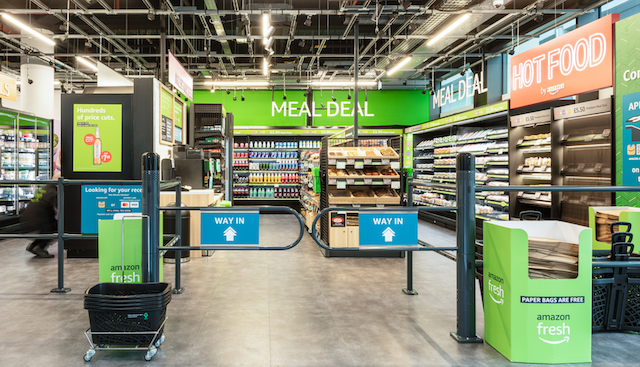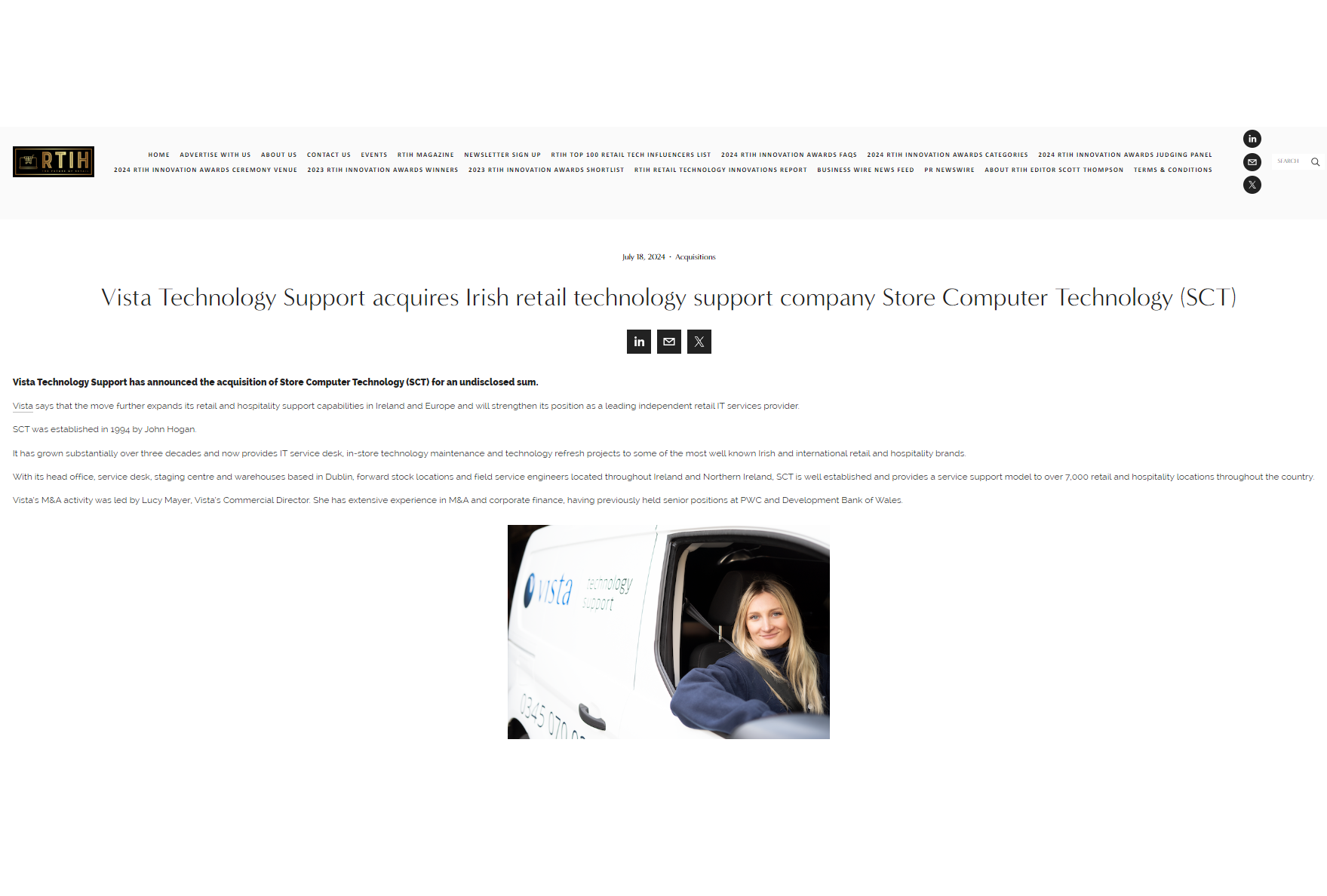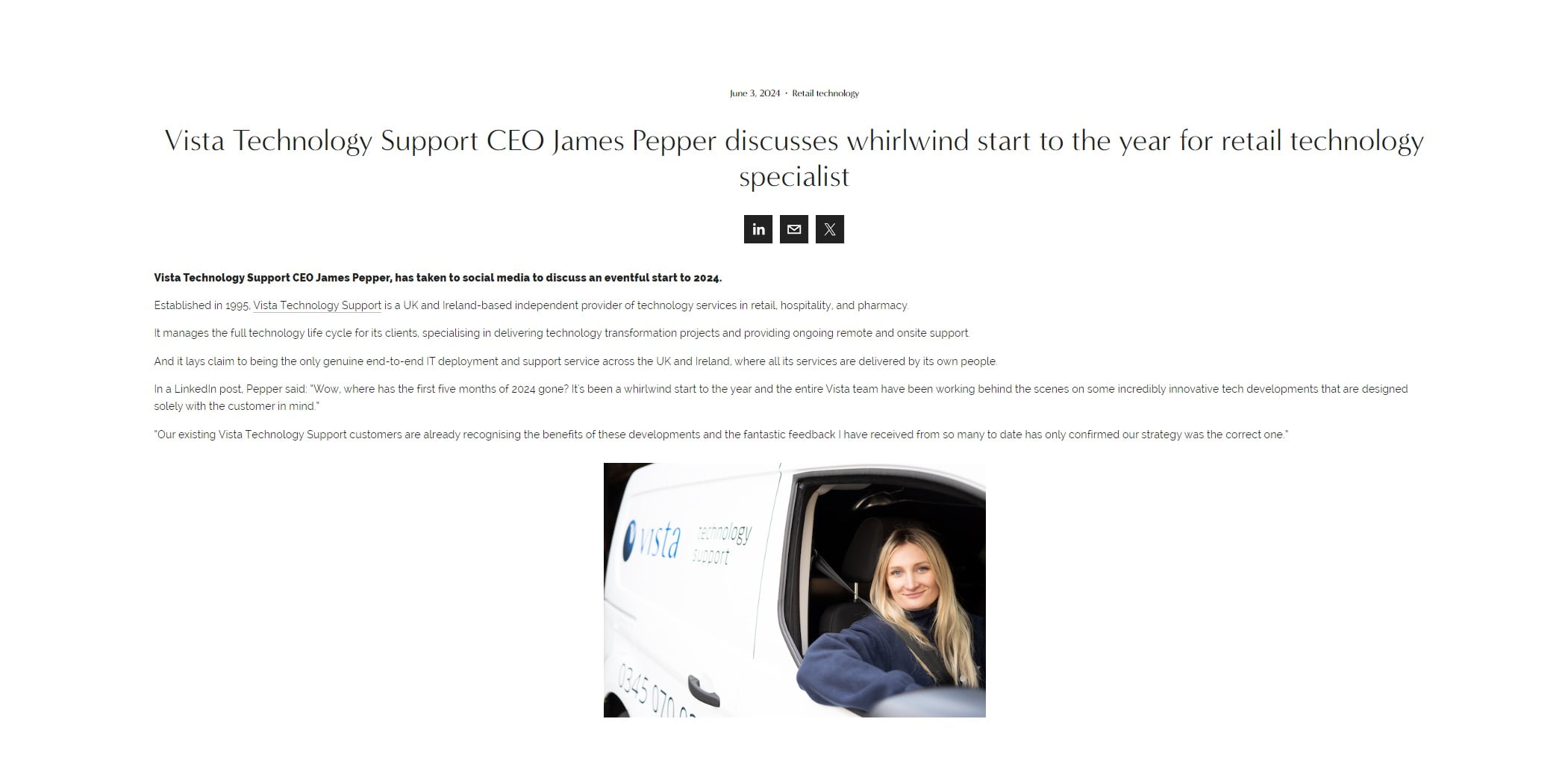Retail Technology Innovation Hub has featured Vista’s latest article titled ‘Vista Technology Support CEO James Pepper talks retail and hospitality technology trends to watch in 2024’ on their website. You can read the full article as it appears on the website below. You can also view the original article, as it appears on RTIH’s website HERE.
2023 brought with it a broad range of macro-economic challenges for the retail and hospitality industry, not only did organisations continue to adapt to post-pandemic changes in consumer buying behaviours but had to contend with rising operational costs, staff shortages and significant increases in stock loss through theft.
In late 2023, there was a noticeable trend that retailers that had previously held back on technology investments, were now committing to introducing new technology in stores; these technologies provide the invaluable connection between online and physical retail.
Whilst there are many technological developments in store for retail and hospitality in 2024, here are a few trends of note:
1. Data led decisions
Timely access to trading data insights is key to the success of all retail and hospitality organisations. In 2024 we will see further investment in systems which will provide businesses with greater access to real-time trading information.
The data collection points span the entire breadth of the customer’s journey, from initial engagement with the customer online or in-store. Retail and Hospitality organisations are far more joined up in their approach to data.
All departments within their organisations are clamouring for insights on the most up-to-date trends, and being able to identify a trend and respond quickly could make the difference between success and failure.
Gone are the days where businesses can wait several weeks to find out if the latest marketing campaign was a success, data insights need to be almost immediate. Purchasing, distribution, logistics, fulfilment and instore or restaurant colleagues all have the need for real-time trading data insights.
The data itself now comes from a range of collection points including the retailer’s website, order management systems (OMS) and in-store through the Point of Sale (PoS), Self-Check Out (SCO), Self Service Kiosk (SSK), and Mobile PoS (MPoS). Data is then collated within a data cloud and through a range of artificial intelligence (AI) tools creates data insights and visuals in the form of dashboards and reports.
2. The digital transformation journey continues
Retailers and restaurants will continue their digital transformation journey in 2024. Despite significant investment by the UK’s tier 1 retail and restaurant organisations over the last few years, there are still substantial digital investments to be made.
Today physical retail and restaurant environments require excellent connectivity; robust, secure and reliable internet connectivity to be exact.
Cloud-based applications, demand for always connected IoT and seamless Wi-Fi and internet connectivity for both colleagues and customers are now expected and important for customer loyalty rather than a nice to have.
The sands of time are running out on legacy internet connectivity with the looming switch off of ISDN and PSTN connections in December 2025.
Recent surveys suggest that 2.9 million UK businesses are still using the legacy technology and could face severe disruption to business operations if they do not upgrade their connections to IP based technology.
With more and more businesses moving to Software Defined Wide Area Networks (SD-WAN), these challenges should be short lived and retail and hospitality organisations will realise return on their tech investments.
At Vista we are also seeing organisations facing challenges where they have started their digital transformation journey and invested in new store technologies which have substantially increased the requirement for greater internet connectivity.
However, the technology is not able to achieve its full potential as the internet connectivity is poor.
When businesses consider their in-store technology strategy, they often overlook their network structured cabling. It is estimated that 40% of UK stores and restaurants’ existing data cabling is considered legacy and that it will cause a degradation in the performance of any new network technology.
Vista’s Data cabling design and installation teams have resolved high network latency issues (slow performing networks) for a broad range of businesses across a wide range of sectors including retail, hospitality, cinemas, schools and colleges.
3. Wearable tech
This year retail and hospitality organisations will continue to invest in wearable technology to capitalise on organisational efficiencies, aid training and development of colleagues and also help enhance the customer experience.
On the flip side, wearable tech is being adopted by retailers in the form of body cameras to help with loss prevention and the safeguarding of instore colleagues. Vista has worked with several large scale retailers who have invested wearable tech in 2023 and we are seeing this trend continue into 2024.
Wearable headsets either guide colleagues to assist them in completing tasks in store or enable them to request assistance from others such as the store manager or supervisor.
We are seeing that wearable tech is mobilising the retail and hospitality workforce and whereas traditionally a store manager may remain in an office, they are now able to complete most office based tasks whilst walking around the store.
Hospitality will continue to be a growth sector for wearable headsets. Quick Service Restaurants (QSR) with drive thru capability were the early adopters using the tech to improve instore communications, enabling colleagues to connect and speak within the restaurant or coffee shop, providing them with the flexibility to multitask, receive and process orders for customers anywhere within the restaurant or drive thru.
Thus providing these businesses with significant operational efficiency gains.
4. Self-service systems
The self-service kiosk has been around for over a century in various forms including vending machines.
However, in the last few years there has been a shift within retail and hospitality to enable customers to serve themselves, whether that is via mobile apps, through instore mobile scan and go technology and more recently Just Walk Out style technologies.
Whilst the real success of all of the above tech is yet to be proven, the one thing that is very clear is that these organisations are experimenting with various technologies with the aim of engaging with their customer through a shopping preference of their choice, to provide operational efficiency and better manage human resource shortfalls.
There is also the challenge that faces all businesses. They have to provide a range of payment options for customers without alienating any customer demographic including customers who prefer to pay by cash which incidentally accounts for 14% of all transaction payments, second only to debit card payments.
Retail and hospitality businesses will continue to invest in self-service technology in 2024. At Vista we are seeing a 30% increase in demand for self-service technology sourcing and projects within the grocery, convenience and QSR sectors.
These businesses are committing to either a refresh of existing self-service technology with the latest self-service spec systems or adding self-service technology to their existing technology infrastructure.
In 2023 Vista sourced, configured and installed self-service kiosks into a range of physical trading environments including cinemas, coffee shops, takeaways and betting shops.
We are assisting a range of customers from different sectors in selecting the technology that is the best fit for their strategy and their customer journey in 2024 and beyond.
Self-service check-outs for that matter are also evolving to assist retailers with optimisation of their in-store operations, AI such as computer vision embedded with the SCO imaging capability helps identify products that are not scanned but bagged; also intelligent image recognition identifies the product being scanned without the need for a barcode which speeds up the checkout experience especially when handling loose fruit and vegetables.
The latest SCO technology also links seamlessly to in-store security systems and has CCTV which records the transaction and identifies any suspicious activity detected at the point of purchase.
Lastly, whilst SCO technology has traditionally been designed for basket purchases, as retailers reduce the number of belted checkouts available, some grocers are investing in belted SCO systems to cater for customers with larger volume purchases.

5. Automation
Whilst there is a whole plethora of technology that is being deployed by retail and hospitality organisations to automate warehouse and fulfilment activities such as picking, packing, shipping and in some cases delivery utilising an extensive range of technologies including robotics and RPA (soft robotics), in physical locations such as stores and restaurants organisations are embracing connected technologies to drive efficiency and consumer convenience and experience.
Cashierless stores were tipped to be the future of retail prior to the pandemic, Amazon Just Walk Out technology leading the way and bold statements being made about the tech giant achieving an autonomous store estate of over 2,000 by 2023.
Fast forward to 2024 and Amazon has reportedly 43 Just Walk Out tech enabled stores worldwide through its Amazon Go and Amazon Fresh brands, the latter having UK expansion plans halted in 2022 after the existing 19 stores failed to achieve forecasted sales.
This doesn’t mean the end for cashierless stores, just like all technology, it will evolve over time.
We are seeing more traditional retailers experimenting with their own take on cashierless autonomous stores including a number of the UK’s largest brands opening their own in London.
These stores leverage a selection of technologies including Machine Vision, Shelf edge sensors, QR codes, RFiD tags, digital shelf edge labels, autonomous entry and exits gates, imaging scanners and contactless payment devices.
At present, the location of cashierless retail environments is one of the most important considerations for a retailer.
To date, the most successful deployments have been in controlled, gated environments such as large offices, stadia, travel hubs and campuses where there is substantial consumer footfall, small basket sizes and the need for speedy transactions.
In 2024, we will see more retail and hospitality businesses explore the use of this technology. However how and where they choose to deploy the technology and exactly which technologies they use to ultimately make the technology a success for their business is yet to be defined.
About the author
James Pepper is CEO at Vista Technology Support, a retail technology sourcing, deployment and support company. He has over 25 years’ experience within the retail, hospitality and pharmacy technology sectors.


